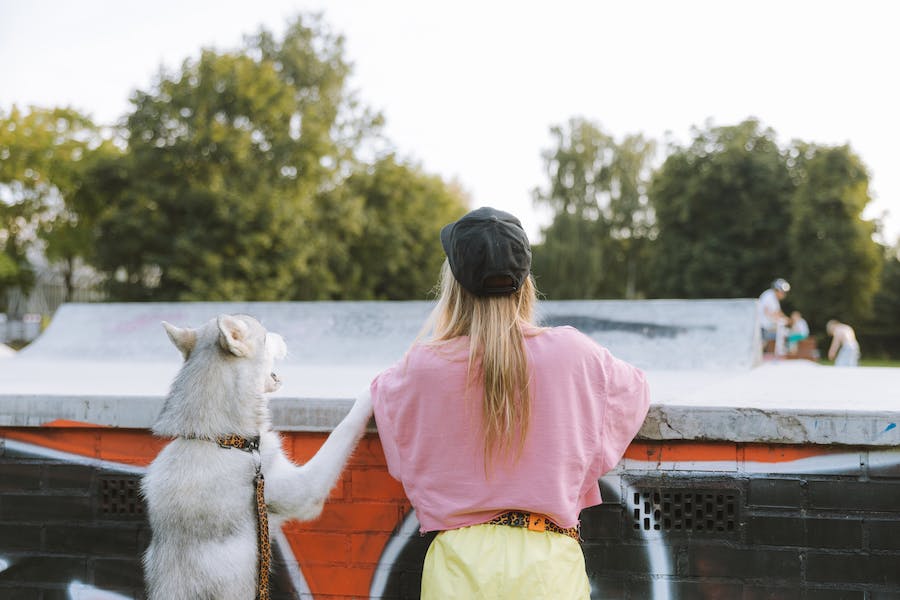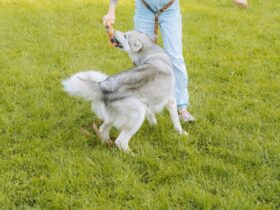Potty training a Husky puppy can be both rewarding and challenging. As a proud owner of this energetic and intelligent breed, you’re likely eager to teach your new furry family member the ropes regarding proper bathroom behavior. However, Huskies, known for their independent streak, require a unique approach to potty training. In this comprehensive guide, we’ll walk you through the essential steps and techniques to successfully potty train your Husky puppy, helping you establish a harmonious and clean living environment for you and your four-legged friend. Say goodbye to accidents and hello to a well-behaved Husky!
How To Potty Train Husky Puppy?
Understand Your Husky Puppy’s Needs:
Begin by recognizing that Husky puppies have their own pace when it comes to learning. They are intelligent but also known for their independent streak. Knowing your puppy’s unique characteristics will help you set realistic expectations for the training process.
Gather Necessary Supplies:
To start, gather the essential supplies for potty training. These include a crate, puppy pads or newspaper, an enzymatic cleaner for accidents, treats for rewards, and a leash. Having these items readily available will help you manage the training process efficiently.
Designate a Potty Area:
Select a specific outdoor area as the designated potty spot for your Husky puppy. Consistency in location will help your pup associate that spot with going potty, making it easier for them to understand where they should do their business.
Establish a Routine:
Dogs thrive on routines, and establishing a consistent daily schedule is crucial for successful potty training. This routine should include specific meal times, playtime, and bathroom breaks. Puppies typically need to go outside shortly after eating, drinking, waking up, or engaging in vigorous play.
Crate Training:
Crate training is a valuable tool for potty training. Dogs instinctively avoid soiling their sleeping area, making the crate an effective aid in preventing accidents. Ensure the crate is appropriately sized, allowing your puppy to stand, turn around, and lie comfortably.
Positive Reinforcement:
Use positive reinforcement as your primary training technique. When your Husky puppy eliminates in the designated potty area, reward them with treats and enthusiastic praise. Positive reinforcement reinforces good behavior and motivates your puppy to repeat it.
Avoid Punishment:
Never scold or punish your puppy for accidents indoors. This can create fear or anxiety, hindering the training process and damaging the bond between you and your Husky. Instead, focus on positive reinforcement and redirection.
Timing and Frequency:
Take your puppy outside regularly, especially during critical times like after meals, playtime, and bedtime. Be patient and wait for them to finish. Praise and reward them when they go potty outside.
Identify Signs:
Learn to recognize the signs that your Husky needs to go, such as sniffing, circling, whining, or pacing. When you notice these signals, take your puppy outside immediately to prevent accidents indoors.
Dealing with Accidents:
Accidents are part of the learning process, especially during the early stages of training. When accidents happen, clean up the mess promptly using an enzymatic cleaner to eliminate lingering odors that might attract your puppy back to the same spot.
The Basic Potty Training Techniques
Potty training your Husky puppy involves several fundamental techniques that lay the foundation for successful training:
Crate training is a valuable tool in potty training. Dogs have an instinct to avoid soiling their sleeping area. Use an appropriately sized crate for your Husky puppy, ensuring it’s just big enough for them to stand, turn around, and lie down comfortably. The crate is a safe space for your puppy and prevents accidents when you can’t supervise them closely.
Positive reinforcement is the cornerstone of practical potty training. Whenever your Husky puppy eliminates in the designated potty area, immediately offer praise, petting, and small treats as rewards. This positive feedback helps your puppy associate going potty in the right place with positive outcomes, encouraging them to repeat the behavior.
It’s crucial to avoid scolding or punishing your puppy for accidents indoors. Punishment can create fear, anxiety, and confusion, making the training process more challenging. Instead, focus on redirection and positive reinforcement. If you catch your puppy in the act of having an accident indoors, calmly interrupt them and take them outside to finish.
Use consistent commands or cues to let your puppy know it’s time to go potty. For example, you might say “go potty” or “do your business” each time you take them to the designated potty area. Consistency in your commands helps your Husky understand what’s expected of them.
Take your Husky puppy outside frequently, especially during critical times such as after meals, playtime, waking up, and bedtime. Puppies have smaller bladders and shorter attention spans, so they’ll need more frequent bathroom breaks. Be patient and wait for them to finish, rewarding them when they do.
Accidents indoors are inevitable during the potty training process. Avoid punishment When accidents occur and clean up the mess promptly using an enzymatic cleaner. This type of cleaner helps obliterate the odor, reducing the chances of your puppy revisiting the same spot for elimination.
As your Husky puppy becomes more reliable in potty training, you can gradually extend their freedom inside the house. Start with short periods of supervised access to other areas of the house and gradually increase the time as they demonstrate progress and fewer accidents.
Benefits Of Crate Training For Potty Training
Crate training is efficient for potty training puppies, including Huskies, due to its numerous benefits. Here are the key advantages of crate training for potty training:
- Instinctual Behavior: Dogs have an instinct to keep their sleeping area clean. When a crate is appropriately sized, it becomes a den-like space where your puppy is less likely to soil. This instinct helps them hold their bladder and bowels, reducing the likelihood of accidents indoors.
- Accident Prevention: The confined space of the crate prevents your puppy from wandering around the house and having accidents when you can’t supervise them. This helps maintain a clean living environment and minimizes the chances of your puppy developing undesirable habits.
- Establishing a Routine: Crate training helps establish a routine for your puppy. Dogs thrive on schedules, and using the crate lets you control when your puppy eats, plays, and goes potty. This consistency makes it easier for your puppy to predict when to eliminate.
- Adequate Supervision: When you can’t actively watch your puppy, placing them in the crate keeps them safe and prevents them from getting into trouble. This is especially important during the early stages of potty training when your puppy may not yet understand where it’s appropriate to go.
- Reducing Anxiety: An adequately introduced and used crate can provide your puppy with a sense of security. It can serve as a calming refuge where they can relax and feel safe. This can be especially beneficial for Huskies, who are known for their independent nature and may feel more comfortable having a designated space.
- Facilitating Outdoor Trips: Crate training involves taking your puppy outside immediately after releasing them from the crate. This reinforces the connection between going potty and being outdoors. Your puppy is more likely to relieve themselves promptly when taken outside after crate time.
- Effective Housebreaking: As your puppy becomes more accustomed to the crate and their schedule, they will learn to “hold it” until they are taken outside. This behavior is essential for effective housebreaking, as your puppy learns to associate going potty with the designated outdoor area.
- Preventing Accidents at Night: Crate training is beneficial at night. Most puppies cannot hold their bladders all night, but a crate can help them gradually develop the habit of holding it for extended periods. This reduces nighttime accidents and helps both you and your puppy get a better night’s sleep.
- Gradual Freedom: As your Husky puppy becomes more reliable with potty training, you can gradually increase their freedom around the house. The crate is a transitional tool, allowing you to extend their unsupervised time while minimizing the risk of accidents.
Conclusion
Crate training is a highly effective method for potty training Husky puppies. Its benefits include accident prevention, routine establishment, reduced anxiety, and the development of good bathroom habits. When introduced and used correctly, a crate provides your puppy with a safe and secure space while facilitating a clean and organized living environment. It is crucial in helping your Husky learn when and where to go potty, setting them up for a successful and well-adjusted future as a house-trained pet.
FAQ’s
Q. How do I stop my Husky puppy from pooping in the house?
A. To stop your Husky puppy from pooping in the house, focus on consistent potty training techniques, supervision, and positive reinforcement. Create a routine, use a crate, and take them outside frequently, especially after meals and playtime. Praise and reward them when they go potty outdoors, and be patient throughout the training process.
Q. How long can a Husky go without pooping?
A. Huskies, like other dogs, typically need to poop every 6 to 12 hours. However, individual variations in metabolism and diet can affect this timeframe. Establishing a regular potty schedule and monitoring your Husky’s bowel habits is essential to ensure their well-being. If you notice any significant changes or concerns, consult your veterinarian.
Q. How do I know if my Husky needs to poop?
A. You can often tell if your Husky needs to poop by observing signs like restlessness, sniffing the ground, circling, whining, or sudden changes in behavior. Pay attention to these cues, especially after meals, playtime, or waking up, and take your Husky outside promptly when you notice these signs to encourage them to go potty in the designated area.







Leave a Reply